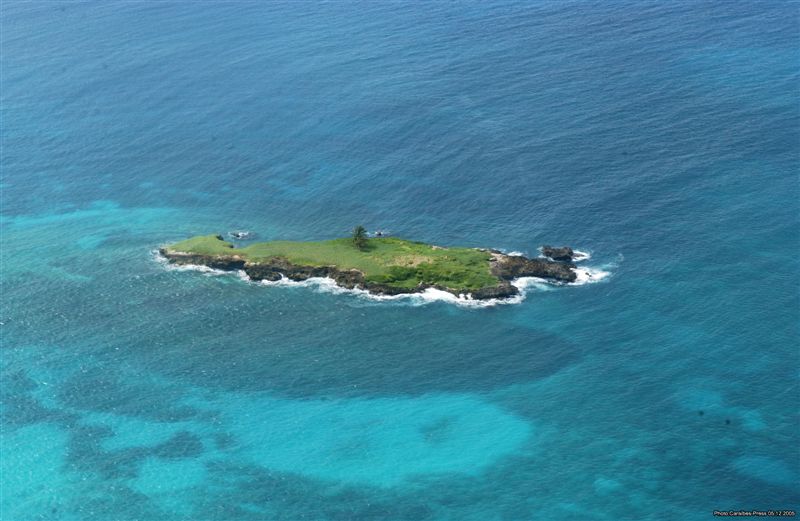In October 2018, the Pacific Ocean brewed one of most intense hurricanes ever recorded, AND it hit one of the most remote places in the world.
2018年10月,太平洋积聚了有史以来最强的飓风之一,袭击了世界上最偏远的地区之一。
With so much force, it eliminated an entire island overnight.
因为飓风威力实在太过强大,某个岛屿一夜之间竟然消失了。
But this isn't the first time an island has vanished.
然而,这并不是第一次有岛屿消失。
It's part of a trend, so what's behind it?
岛屿消失如今已经成了一种趋势了,那么,这背后的原因是什么呢?
The island we're talking about is East Island, located about 890 km northwest of Honolulu, Hawaii.
我们谈论的这座岛屿就是西北方向距离夏威夷檀香山约890公里处的东岛。
It may not seem like much - only 11-acres,
这座岛看起来或许不大——只有11英亩(约4.45万平方米),
but it's part of one of the world's largest protected marine areas.
却是世界上最大的海洋保护区之一。
The region was home to diversity rarely found anywhere else on earth.
该地区有着地球上其他地方很少发现的生物多样性。
It was a nesting ground for over 95% of the Hawaiian endangered green sea turtle population
夏威夷95%以上濒临灭绝的绿海龟都在这里筑巢,
and about 200 critically endangered Monk seals visit the area each year.
每年还会有大约200只极度濒危的僧海豹来到这里。
And considering there's only 1,400 of these monk seals left in the state, it's a big deal.
考虑到我国已经只剩1400只僧海豹,这座岛的存亡就变得事关重大了。
East island is now a mere 46 meter patch of sand and scientists estimate about 95% of the islet is underwater.
东岛如今已经变成了一条仅长46米的沙滩了,科学家估计这座小岛95%的部分都已经在水下了。
Scientists don't know if this critical habitat will bounce back anytime soon,
科学家不知道这个关键的栖息地是否会很快重新浮出水面,
and are very concerned, since islands just don't disappear overnight, right?
对此他们也非常担心,因为岛屿是不会一夜之间消失的对吧?
It takes years and years of erosion.
需要年复一年的侵蚀。
But islands are disappearing faster and it's becoming more common.
问题是,岛屿消失的速度越来越快,而且越来越普遍了。
Scientists have observed entire islands swallowed whole from sea level rise in a matter of a few short years.
科学家们观察到过短短几年的时间内,上升的海平面吞没整个岛屿的情形。
From 2007 to 2014 alone, 6 low-lying islands in Micronesia vanished without a trace.
仅2007年到2014年,密克罗尼西亚就有6个低洼岛屿消失得无影无踪。
Those were uninhabited,
那些岛屿都是无人居住的,
but as recently as 2017, people of the Carteret Islands of Papua New Guinea are leaving their island homes for higher ground.
然而,就在2017年,巴布亚新几内亚卡特里特群岛的居民已经开始离开岛上的家园,前往地势较高的地方了。
As they avoid the rising sea levels, they also face dying trees, scarcity of food, and freshwater.
他们在躲避海平面上升的同时,还要面临树木枯死、食物短缺和淡水短缺等问题。
They aren't the only ones either.
而且,他们并不是唯一面临这一处境的人群。
The Maldives, Fiji, Marshall Islands, Republic of Kiribati, and Torres Strait Islands are all being affected by rising sea levels.
马尔代夫、斐济、马绍尔群岛、基里巴斯共和国和托雷斯海峡群岛都受到了海平面上升的影响。
Island nations across the globe are facing these same obstacles,
世界各地的岛国都面临着同样的阻碍,
because they're the most vulnerable to the results of climate change.
因为岛国最容易受到气候变化的影响。
But wait, East Island didn't disappear from sea level rise, that was the fault of Hurricane Walaka.
不过,等一下,东岛并不是因为海平面上升消失的,东岛的消失是瓦拉卡飓风造成的。
There's a connection, because sea level rise can actually make the consequences of hurricanes worse.
但飓风和海平面上升也是有联系的,因为海平面上升实际上会使飓风的破坏力变得更强。
Higher sea levels means stronger storm surges,
更高的海平面意味着更强的风暴潮,
which create higher floods of water that move further inland.
洪水的水位就会更高,涌入内陆后也走得更远。
Hurricane Walaka was actually one of two major tropical storms in the pacific;
瓦拉卡飓风实际上是太平洋两大热带风暴之一;
one on each side of the ocean that reached Category 5 at the same time,
两者在太平洋两岸能够同时达到5级的风力,
meaning they were forming over 250 kilometer per hour winds.
这就意味着它们会形成风速超过每小时250公里的飓风。

Not only is this intense, but it's highly unusual behavior.
飓风不仅风速会如此强劲,其行为也会变得极不寻常。
Hurricane Walaka was much further north than most hurricanes travel.
瓦拉卡飓风向北移动的距离就比大多数飓风都要远得多。
Scientists speculate that's because the Pacific's waters are warming.
科学家推测,这是因为太平洋的海水变暖的缘故。
You see, typically hurricanes are near the equator because that's where warmer waters are.
原来啊,飓风通常都出现在赤道附近,因为那里水温较高。
Tropical storms form when warm air rises from warm water, causing low air pressure underneath it.
当温暖的空气从温暖的水面升起,导致暖空气下方的气压很低,热带风暴就形成了。
Nearby, higher pressure air will then push into the low air pressure, and that new air becomes warm and rises up.
附近高压空气会被挤入低压空气中,新混合的空气就会变暖然后上升。
Nearby air will then come in and take the warm air's place as it rises.
附近的空气继续进来,并在上升的过程中取代原来的暖空气。
In the upper atmosphere, the warm air cools down and creates clouds.
在上层大气中,高温空气冷却形成云层。
This becomes a swirling system of hot and cold air being fed by the ocean's heat and water evaporation.
这就形成了一个由海洋表面的高温不断输送的冷空气和热空气以及水分蒸发构成的漩涡系统。
In theory, more energy is released into the storm, when there is a larger temperature between the warm water and upper atmosphere.
理论上,海洋表面温暖的海水和上层大气之间温差较大时,会有更多的能量被释放到风暴中。
Although climate scientists debate and can't directly link storms to climate change,
尽管气候科学家争论不休也不能将风暴与气候变化直接联系起来,
they all agree that warm waters also cause stronger storms.
但他们都认为,更温暖的海水也会引起更大的风暴。
And let's face it, the pacific ocean is getting mighty toasty.
就让我们面对现实吧,太平洋已经变得越来越温暖了。
It turns out that 2017 was a record-breaking year for ocean waters.
事实证明,2017年是海洋水域温度破纪录的一年。
But hurricanes are not just getting severe in some far off distance place in the Pacific,
但飓风不只是在太平洋某个遥远的地方变得越来越严重,
we can see the intensity from the Atlantic as well.
从大西洋也能看出现在飓风的强度。
The recent North Carolina hurricane dropped over 75 cm of water on parts of North Carolina
比如最近,北卡罗莱纳飓风在北卡罗莱纳部分地区就造成了75厘米以上的降雨,
and many areas were flooded and blocked off.
许多地区都被淹没封锁了。
As for East Island, we'll see how it fairs.
至于东岛,我们还是拭目以待吧。
NOAA will monitor the islands progress to see how the animals respond to their habitat loss,
国家海洋和大气管理局(NOAA)将监测这些岛屿的进展情况,了解那些动物会如何应对栖地的丧失,
and what they find will help them manage the species.
他们的发现将有助于我们管理那些物种。
Some monk seals can already be seen lifting themselves up on the small patch left behind.
我们已经能看到一些僧海豹爬上仅剩的那一小块沙滩。。
So yes, sea levels are rising, hurricanes are getting worse, and they're wiping places off the map.
所以,是的,海平面是在上升,飓风是越来越严重了,它们正将一些地方从我们的地图上抹去。
While we can't witness what's going on beyond our backyards,
虽然我们无法目睹在我们的后院发生了什么,
it's all happening right now, even if we can't see it.


